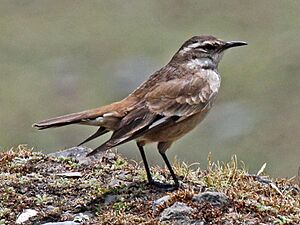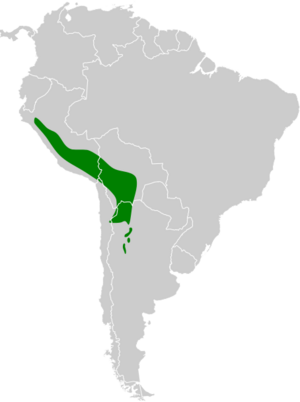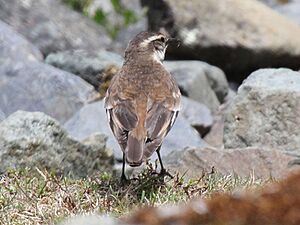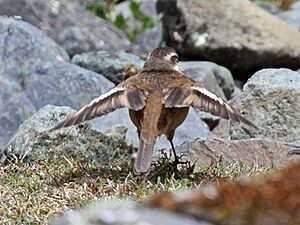Cream-winged cinclodes facts for kids
Quick facts for kids Cream-winged cinclodes |
|
|---|---|
 |
|
| Conservation status | |
| Scientific classification | |
| Genus: |
Cinclodes
|
| Species: |
albiventris
|
 |
|
| Synonyms | |
|
|
The Cream-winged Cinclodes (Cinclodes albiventris) is a type of bird. It belongs to the ovenbird family called Furnariidae. You can find this bird in parts of Argentina, Bolivia, Chile, and Peru.
Contents
About the Cream-winged Cinclodes
How Scientists Classify This Bird
Scientists often study birds to understand how they are related. The Cream-winged Cinclodes used to be grouped with another bird, the Bar-winged Cinclodes. But around 2009, scientists decided it was different enough to be its own species. This is called a "species split." The Bar-winged Cinclodes was then renamed the Buff-winged Cinclodes to avoid confusion.
The Cream-winged Cinclodes has five different types, called subspecies:
- C. a. albiventris
- C. a. tucumanus
- C. a. riojanus
- C. a. rufus
- C. a. yzurietae
What Does the Cream-winged Cinclodes Look Like?
This bird is fairly small, about 15 to 19 centimeters (6 to 7.5 inches) long. It weighs about 20 to 34 grams (0.7 to 1.2 ounces). Both male and female birds look the same.
The main type, C. a. albiventris, has a light, creamy-white stripe above its eye. Its cheeks are white. The top of its head and back are rusty-gray. Its wings are dark brown with wide, creamy edges. A cream-colored band crosses its flight feathers. Its tail feathers are dark brown, with the outer ones having milky-buff tips. The bird's belly and chest are whitish. It has dark brown eyes and a dark bill. Its legs and feet are also dark.
Other subspecies have slight differences in color. For example, C. a. yzurietae has darker brown upper parts. C. a. rufus has more reddish-brown upper parts. C. a. riojanus is darker chocolate-brown on its back. C. a. tucumanus has a deeper cream band on its wings.
Where Does the Cream-winged Cinclodes Live?
Its Home Range
The most common type, C. a. albiventris, lives in the Andes mountains. This range stretches from northern Peru, through western Bolivia and northern Chile, down into northwestern Argentina.
The other subspecies live in specific areas of Argentina:
- C. a. tucumanus is found in Tucumán Province.
- C. a. riojanus lives in the Sierra de Famatina.
- C. a. rufus is in the Campo de Arenal area of Catamarca Province.
- C. a. yzurietae is also in Catamarca, in the Sierra del Manchao.
What Kind of Places Does It Like?
The Cream-winged Cinclodes prefers open, grassy areas. This includes páramo and puna grasslands. It also lives near farms and in dry mountain scrublands. You'll often find it close to water, like bogs and streams. It can even be seen near human homes.
These birds live at high elevations. In Chile, they are found between 2,500 and 5,000 meters (8,200 to 16,400 feet) high. In Peru, they are mostly between 2,750 and 4,800 meters (9,000 to 15,700 feet). In Argentina, they usually live above 2,100 meters (6,900 feet).
How Does the Cream-winged Cinclodes Behave?
Staying or Moving?
Most Cream-winged Cinclodes birds stay in the same area all year. They are "residents." However, some might move to lower places in winter. They also move if the weather is bad or if their favorite feeding spots dry up.
What Does It Eat?
This bird eats many small creatures without backbones, like insects. It also eats seeds. It looks for food alone or in pairs. It hops and runs on the ground. It pokes its bill into wet or dry ground, rocks, grass, and even shallow water to find food.
How Does It Raise Its Young?
The Cream-winged Cinclodes breeds in the spring and summer. They are monogamous, meaning a male and female pair up. Males sing and flap their wings to attract a mate.
They build their nests in burrows. These burrows are tunnels they dig into earth banks. They might also use holes in human-made walls. The nest chamber is lined with grass and hair. They usually lay two eggs. Scientists don't know much about how long the eggs take to hatch or how long the chicks stay in the nest. It's thought they might raise two groups of chicks in one season.
What Does It Sound Like?
The song of the Cream-winged Cinclodes has been described in different ways. Some say it sounds like "cheet, cheet, cheet, prre EEEEOOOO, OOOOEEEEEE’cheet’ cheet’cheet...". In Chile, it's described as a rising, twittering trill, "trrrreee’i’i’i’i’i'". Its calls are similar to the Buff-winged Cinclodes. These calls include a sharp "pfip" and high-pitched tinkling notes. When flying, it makes a sharp, whistled "tsip."
What Is Its Conservation Status?
The IUCN (International Union for Conservation of Nature) has listed the Cream-winged Cinclodes as "Least Concern." This means it's not currently in danger of disappearing. It lives across a large area. Its total population size isn't known, but it seems to be stable. No major threats have been found. It's considered common in most places where it lives. In some areas, it's the most common type of cinclodes. Its habitats are usually not disturbed much by people. It might even benefit from grazing animals.
Images for kids





